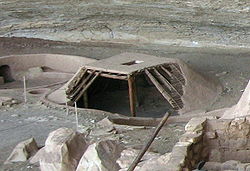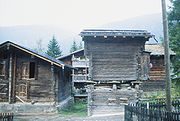
Pit-house
Encyclopedia


These structures may be used as places to tell stories, dance, sing, celebrate, and store food. In archaeology
Archaeology
Archaeology, or archeology , is the study of human society, primarily through the recovery and analysis of the material culture and environmental data that they have left behind, which includes artifacts, architecture, biofacts and cultural landscapes...
, pit-houses are also termed sunken featured buildings and are found in numerous cultures around the world. These include: the people of the American Southwest, including the ancestral Pueblo, the ancient Fremont
Fremont culture
The Fremont culture or Fremont people is a pre-Columbian archaeological culture which received its name from the Fremont River in the U.S. state of Utah where the first Fremont sites were discovered. The Fremont River itself is named for John Charles Frémont, an American explorer. It inhabited...
and Mogollon cultures, the Cherokee
Cherokee
The Cherokee are a Native American people historically settled in the Southeastern United States . Linguistically, they are part of the Iroquoian language family...
, the Inuit
Inuit
The Inuit are a group of culturally similar indigenous peoples inhabiting the Arctic regions of Canada , Denmark , Russia and the United States . Inuit means “the people” in the Inuktitut language...
, the people of the Plateau, and archaic residents of Wyoming (Smith 2003) in North America; Archaic residents of the Lake Titicaca Basin
Jiskairumoko
Jiskairumoko is a pre-Columbian archaeological site south east of Puno, Peru. The site lies at 4,115 meters , in the Aymara community of Jachacachi, adjacent to the Ilave River drainage, of the Lake Titicaca Basin, Peru...
(Craig 2005) in South America; Anglo Saxons in Europe; and the Jōmon people
Jomon period
The is the time in Japanese prehistory from about 14,000 BC to 300 BC.The term jōmon means "cord-patterned" in Japanese. This refers to the pottery style characteristic of the Jōmon culture, and which has markings made using sticks with cords wrapped around them...
in Japan. Anglo Saxon pit-houses may have actually represented buildings for other functions than just dwellings and have a specialised name derived from German, "Grubenhäuser"
Usually, all that remains of the ancient pit-house is a dug out hollow in the ground and any posthole
Posthole
In archaeology a posthole is a cut feature used to hold a surface timber or stone. They are usually much deeper than they are wide although truncation may not make this apparent....
s used to support the roof. In the nineteenth century, it was believed that most prehistoric peoples lived in pit-houses although it has since been proved that many of the features thought of as houses were in fact food storage pits or served another purpose.
Cross Cultural Patterning
A cross-cultural middle range model of pit-house architecture using the Ethnographic Atlas found that 82 of the 862 societies in the sample occupy pit structures as either their primary or secondary dwellings.(Gillman 1987:540)All but six of the 82 societies live above 32° north latitude, and four of the six cases in this sample that are below 32° north latitude are from “high mountain” regions in east Africa, Paraguay, and eastern Brazil.(Gonzalez 1953) The last example is from the Yami Kano and Segawa (1956) who occupied a small island south of Formosa.
Three conditions were always present among groups in the sample: 1) non-tropical climate during the season of pit structure habitation; 2) minimally a biseasonal settlement pattern; 3) reliance on stored food during the period of pit structure occupation. These conditions may be related to other factors of society and the presence of any or all of these three elements in society does not pre-condition occupation of pit structures. Nonetheless, these three conditions were present in all cases of pit structure occupation present in the Ethnographic Atlas. Other cultural patterns were common, but not universal across the sample. These commonalities include: cold season of occupation, low population estimates, and simple political and economic systems.
The ethnographic sample is based almost entirely on case studies from societies located in northern latitudes. Period of pit structure occupation is generally during the cold season. This is probably due to their thermal efficiency. Dug into the ground, pit structures take advantage to the insulating properties of soil, as well as having a low profile protecting them from exposure to wind induced heat loss.Gillman (1987:542). Since less heat is lost by transmission than above ground structures, less energy is required to maintain stable temperatures inside the structure.Farwell (1981)
Out of the 82 ethnographic cases in the Ethnographic Atlas 50 societies had population estimates and of these 64% had fewer than 100 people per settlement.Gillman (1987:544) In only 6% cases were there more than 400 persons per settlement. The cases with the highest population densities were the Arikara and Hidatsa of the North American Great Plains and the Konso of Ethiopia. Gillman attributes high population densities among the Arikara to the availability of buffalo.
Pit structure occupations are generally associated with simple political and economic systems. For 86% of the sample, class stratification or social distinctions based on non-hereditary wealth were reported as absent.Gillman (1987:547) However, some pit dwelling societies are characterized by chiefdom level complexity. In terms of economic organization, 77% of the societies who occupy pit structures had a hunting and gathering economy.Gillman (1987:545) This is a large fraction of the sample but is not considered a universally consistent feature like biseasonal settlement and a reliance on stored foods during pit structure occupation.
During the part of the year when people are not living in pit structures activities should be focused on acquiring foods to store.Gillman (1987:544) Based on the sample from the Ethnographic Atlas, this may be through either hunting and gathering or agricultural activity.
Reconstructions
There are reconstructions of pit-houses in several open air museums, e. g. in the Hitzacker Archaeological CentreHitzacker Archaeological Centre
The Hitzacker Archaeological Centre is an archaeological open air museum in Hitzacker in the German state of Lower Saxony. The core them of the museum is the presentation of Bronze Age settlements....
, the Kalkriese Museum and Park, the Oerlinghausen Archaeological Open Air Museum , the Hochdorf Chieftain's Grave
Hochdorf Chieftain's Grave
The Hochdorf Chieftain's Grave is a richly-furnished Celtic burial chamber dating from 530 BC. An amateur archaeologist discovered it in 1977 near Hochdorf an der Enz in Baden-Württemberg, Germany...
and in West Stow.
See also
- Dugout (shelter)Dugout (shelter)A dugout or dug-out, also known as a pithouse, pit-house, earth lodge, mud hut, is a shelter for humans or domesticated animals and livestock based on a hole or depression dug into the ground. These structures are one of the most ancient types of human housing known to archeologists...
- Earth houseEarth houseAn earth house is an architectural style characterized by the use of natural terrain to help form the walls of a house. An earth house is usually set partially into the ground and covered with thin growth...
- Earth lodgeEarth lodgeAn earth lodge is a semi-subterranean building covered partially or completely with earth, best known from the Native American cultures of the Great Plains and Eastern Woodlands. Most earth lodges are circular in construction with a dome-like roof, often with a central or slightly-offset smoke...
- Earth shelteringEarth shelteringEarth sheltering is the architectural practice of using earth against building walls for external thermal mass, to reduce heat loss, and to easily maintain a steady indoor air temperature...
- GrubenhausGrubenhausA Grubenhaus is a type of sunken floored building built in many parts of northern Europe between the 5th and 12th centuries AD...
- Kekuli
- KivaKivaA kiva is a room used by modern Puebloans for religious rituals, many of them associated with the kachina belief system. Among the modern Hopi and most other Pueblo peoples, kivas are square-walled and underground, and are used for spiritual ceremonies....

